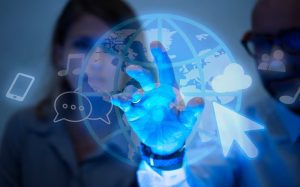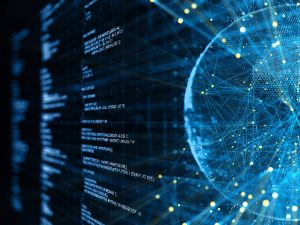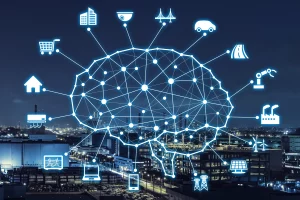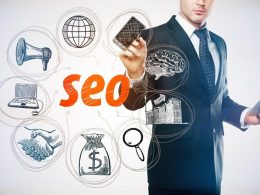The Internet of Things, or IoT, has quickly become a game-changing technology that is changing the way we connect with the outside world. The Internet of Things (IoT) is essentially a network of physically connected items that may communicate with one another via the internet using sensors and software. Numerous automation opportunities in both personal and professional contexts are made possible by these devices’ ability to gather, exchange, analyze, and even remotely control one another.
Knowing the Fundamentals of IoT

Interconnectivity is the core idea behind the Internet of Things. The internet enables devices to communicate with humans and with each other, from refrigerators and thermostats to industrial machinery and automobiles. This connectivity improves control, efficiency, and convenience.
An IoT-enabled thermostat, for instance, allows you to remotely check and control your home’s temperature from a distance using your smartphone. The capabilities of IoT extend far beyond this kind of remote control. From everyday jobs to intricate commercial procedures, interconnected gadgets can streamline everything by sharing data and carrying out tasks without direct human participation.
How the Internet of Things Operates
Devices and sensors: Sensors in a smart home system, for example, may identify movement, light levels, and temperature.
Connectivity: IoT devices require a way to connect, and the internet is usually the foundation for this communication. These gadgets keep linked thanks to wireless technologies like Wi-Fi and Bluetooth.
Data Processing: Following collection, data must be processed. Sometimes this takes place on the device itself, and other times data is transferred to a cloud server for analysis.
User Interface: Usually through web platforms or mobile apps, the user interface enables people to communicate with IoT devices. You may check data, manage devices, and keep an eye on activity here.
In both personal and professional contexts, these elements cooperate to give users a smooth and automated experience.
IoT advantages
There are many advantages to the broad use of IoT in many different industries.
1. Increased Productivity and Efficiency
IoT enables businesses to automate monotonous processes, keep an eye on machinery in real time, and minimize downtime. For instance, industries may schedule maintenance before a serious issue arises by using IoT-enabled gear to predict when equipment might break. This increases operational efficiency overall and avoids expensive malfunctions.
2. Better Ability to Make Decisions

Large volumes of data are gathered and analyzed by IoT devices, which yield insightful information about corporate operations. Everything from supply chain management to customer service may be enhanced by this data-driven decision-making. IoT analytics can help businesses better understand consumer behavior, increase energy efficiency, and manage inventory levels.
3. Remote Control and Monitoring
Users may monitor and operate gadgets at any time and from any location thanks to the Internet of Things. IoT-enabled gadgets, for example, can remotely monitor patients’ vital signs in the healthcare industry, giving clinicians access to real-time data without the patient having to come into the clinic. Homeowners can improve convenience and security by remotely controlling lighting, appliances, and security systems.
4. Financial Savings
IoT has the potential to significantly lower costs for both consumers and enterprises by increasing productivity and decreasing waste. Energy use, labor expenses, and needless repairs can all be decreased with the use of automated procedures. For instance, by automatically modifying heating and lighting according to occupancy, smart homes can maximize energy use and save utility costs.
5. Improved Experience for Customers
By examining consumer preferences and behavior, IoT can be used in retail to generate customized shopping experiences. Smart shelves, for instance, may monitor product inventories in real time and alert employees when supplies are running low. Wearable technology can also make it easier for customers to traverse stores and make product recommendations based on their preferences.
Real-World IoT Examples
Let’s examine a few real-world examples to gain a better understanding of the potential of IoT.
1. Intelligent Houses
Perhaps the most well-known use of IoT is in smart homes. An integrated home automation system is made up of devices that connect with one another, such as voice assistants (like Google Home or Amazon Alexa), lights, security cameras, and smart thermostats. Whether they are at home or not, users may control almost every element of their home environment with voice commands or a mobile app, from locking doors to changing the temperature.
2. Networked Automobiles

With the advent of linked cars, IoT is revolutionizing the automotive sector. To make driving safer and more effective, these cars can communicate with external systems as well as with one another. IoT-enabled vehicles, for instance, may avoid collisions, get traffic updates, and even recognize when a part needs to be maintained. IoT is also crucial to autonomous driving technology.
3. IoT in Industry
IoT is essential for streamlining processes in industrial environments. For example, IoT-enabled sensors are used in manufacturing facilities to track the functioning of their gear in real time. Predictive maintenance is made possible, which lowers downtime and prevents unplanned equipment breakdowns. Overall operational efficiency is also increased by the capacity to track supplier chains, automate production processes, and monitor energy consumption.
1. Case Study: Industrial IoT and General Electric (GE)
In the field of industrial IoT, General Electric (GE) is a pioneer. In order to monitor performance and forecast when maintenance is necessary, GE has integrated the Internet of Things (IoT) into its equipment, including wind turbines and aircraft engines. By using sensors built into these devices, GE gathers information that enables personnel to spot problems before they become serious, cutting down on repair expenses and downtime. According to GE, its IoT solutions have improved operational efficiency and prevented unscheduled downtime, saving millions of dollars.
2. Case Study: Smart Warehouses and Amazon
Amazon has created extremely effective, automated fulfillment centers by integrating IoT into its warehouse operations. RFID (radio-frequency identification) tags, robotics, sensors, and other Internet of Things devices collaborate to make inventory management more efficient. These gadgets help direct robotic systems that pick and pack orders, keep track of goods moving throughout the warehouse, and guarantee appropriate stock levels. Amazon can process and send orders faster by utilizing IoT, which also lowers labor expenses and minimizes human error.
3. Case Study: Precision Agriculture and John Deere
One of the top producers of agricultural equipment, John Deere, incorporates IoT into their precision agriculture technologies. John Deere gives farmers access to real-time information on weather patterns, crop health, and soil conditions by outfitting tractors and other machinery with Internet of Things-enabled sensors. This increases yields and decreases resource waste by enabling farmers to make well-informed decisions about when and where to plant, water, and harvest crops. As a result, farmers may minimize their impact on the environment while increasing their productivity and profitability.
The Internet of Things’ Future

IoT applications will grow much more common as the technology develops further. The Industrial Internet of Things (IIoT) is one field that is expanding rapidly, with more and more companies implementing IoT to streamline their processes. Another new trend that promises to improve urban living is smart cities, where Internet of Things sensors track energy use, traffic, and public safety.
With increasingly sophisticated wearable technology and remote monitoring systems, IoT will continue to transform patient care in the healthcare industry. In addition to monitoring vital signs, smart devices will use AI to anticipate possible health problems before they materialize, enabling preventative care.
In summary
With its previously unheard-of levels of ease, effectiveness, and insight, the Internet of Things is revolutionizing both our personal and professional lives. IoT is enabling the monitoring, control, and optimization of almost every element of everyday life and corporate operations, from smart homes to industrial automation. The Internet of Things is more than just a catchphrase; it is a revolutionary force that is changing our future thanks to practical applications in sectors like manufacturing, agriculture, and healthcare.











